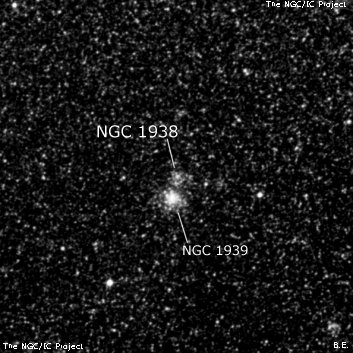
John Herschel discovered NGC 1938 + NGC 1939 = h2848 on 24 Nov 1834 and recorded a "B; R; a double nebula (clouding over)." On a second observation he recorded "pB; S; R; glbM; a double neb. It has a vF neb NGC 1939) attached np." On a third sweep (of 4) he logged "A double neb. Pos 339.1; 50" dist; each F; R; glbM; 35" and 30"." JH catalogued both objects individually in the GC (1144 and 1145). See Corwin's notes for more on the clusters.
James Dunlop possibly discovered this "double cluster" on 24 Sep 1826 and described D 89 as a "pretty well-defined round nebula, about 20" diameter." His position is ~5' NE of NGC 1938 and 1939. Perhaps he noticed the combined glow of these clusters (though the size would then be much too small), or he picked up only NGC 1939, which is the brighter cluster. Another possibility is D 90, described as "a small round faint nebula, north of a small star", refers to NGC 1938 and 1939. His position is 13' SE of the pair of the clusters. Without further information, I don't see how Dunlop can be confidently given credit for the discovery.
600/800mm - 30" (10/18/17 - OzSky): at 264x and 429x; fairly faint, small, round, 25" diameter, nearly even surface brightness. The bright LMC globular cluster NGC 1939 is only 40" SSE. At 429x I noticed a dim cluster, KMK88 50, just 1.8' N of NGC 1938. It was just a very faint, very small knot, 15", low surface brightness.
30" (10/15/15 - OzSky): fainter of a close pair of clusters with brighter NGC 1939 to the south-southeast by just 40". At 303x, NGC 1938 appeared fairly faint, small, round, 24" diameter.
Notes by Steve Gottlieb